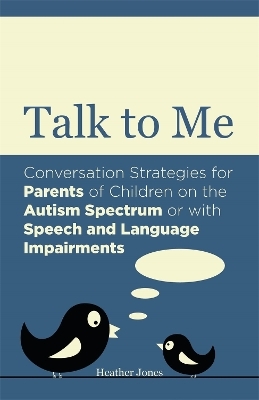
Talk to Me
Jessica Kingsley Publishers (Verlag)
978-1-84905-428-7 (ISBN)
In this hands-on guide, Heather Jones offers practical advice, born of experience with her own son, which will help you teach your child the principles of communication. Full of strategies and examples, it shows how you can allay fears, build confidence and teach your child to enjoy conversation. Once a child gets used to talking with other people, many life skills can develop more easily as they grow up – from making friends and shopping for themselves, to being interviewed and eventually getting a job.
This handy book provides guidance and inspiration to parents, teachers and anyone else who cares for a child who finds language and comprehension difficult.
Heather Jones's son, Jamie, has Asperger Syndrome and severe speech and language impairments. When Jamie was 10, Heather stumbled across a way of getting through to him. Over the years she developed this methodology in more detail, calling it conversational therapy, and has never looked back. Jamie is now 19 and can hold a conversation, which has enabled him to go on to achieve much more, including passing his driving test and getting a job. Heather is the Director of Milkwood Educational, which publishes ESL textbooks in the Far East. She lives in Queensland, Australia.
Preface. Part I. Working on Conversation. 1. Increasing Vocabulary is Not Enough! 2. How to Get Your Child Talking. 3. Demanding a Conversation from Your Child. 4. It's Never Too Late to Start Encouraging Conversation. 5. Talking about a Diagnosis. 6. Finding a Reward System that Your Child Can Verbalise. 7. Using a Diary as a Conversation Catalyst. 8. Teaching Your Child to Ask 'Wh' Questions. 9. Teaching Turn-Taking in Conversation. 10. Teaching Your Child to Be an Active Listener. 11. Being an Active Listener for Your Child. 12. Teaching the Importance of Staying on Topic (without Over-Indulging in Special Interests). 13. What is Phatic Communication and Why is it Important? 14. Encouraging the Use of Names. 15. How to Help Family and Friends Have Conversations with Your Child. 16. Talking about Body Language and Emotions with Your Child. 17. Understanding the Importance of Pauses and Silence. 18. Making the Most of Stories and Story-Telling. 19. Using Mind-Maps to Improve Conversation. 20. Coping with Idioms and Incorrect English. 21. Teaching Your Child to Verbalise Distress (and Avoid Meltdown). 22. Conversation Starters in the Supermarket. 23. Conversation Starters on Car Journeys. 24. Conversation Starters and Special Interests. 25. Encouraging Conversation with Games and Puzzles. Part II: Developing Social Skills, Life Skills and Independence. 26. Making Friends. 27. Dealing with Authority Figures. 28. Birthday Parties and Youth Groups. 29. Planning for Practical Life Skills. 30. Using Mind-Maps to Develop Abstract Life Skills. 31. Organising Daily Life and Establishing a Routine. 32. Giving Your Child Responsibility for Daily Tasks. 33. Preparing Your Child to Organise His Life. 34. What Your Child Can Learn from Caring for a Pet. 35. Preparing Your Child for Cooking. 36. Preparing Your Child to Manage Money. 37. Noticing the Absence of Meltdowns and Encouraging Resilience. 38. Preparing Your Child for Job Interviews. 39. Preparing Your Child for Driving. 40. Preparing for the First Day at Work. Afterword. Where Are We Now? Appendix 1. Charting Your Child's Progress.
| Erscheint lt. Verlag | 21.2.2014 |
|---|---|
| Verlagsort | London |
| Sprache | englisch |
| Maße | 173 x 219 mm |
| Gewicht | 228 g |
| Themenwelt | Sachbuch/Ratgeber ► Gesundheit / Leben / Psychologie ► Familie / Erziehung |
| Medizin / Pharmazie ► Gesundheitsfachberufe ► Logopädie | |
| Sozialwissenschaften ► Pädagogik ► Sonder-, Heil- und Förderpädagogik | |
| ISBN-10 | 1-84905-428-2 / 1849054282 |
| ISBN-13 | 978-1-84905-428-7 / 9781849054287 |
| Zustand | Neuware |
| Haben Sie eine Frage zum Produkt? |
aus dem Bereich


